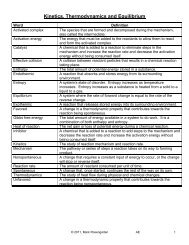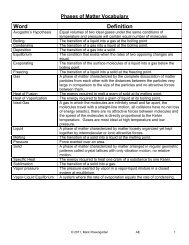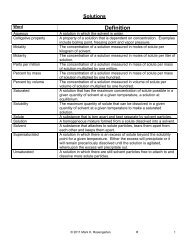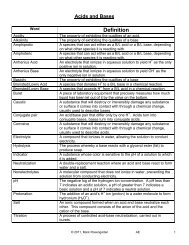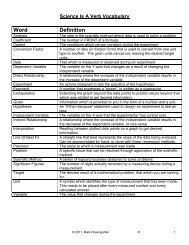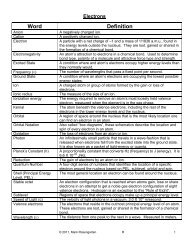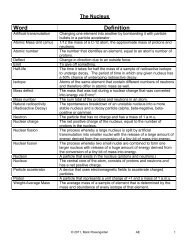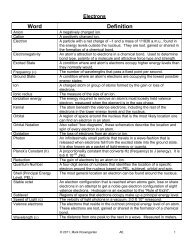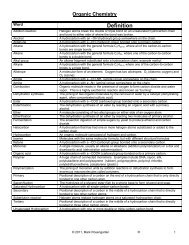Unit 4 - Mark Rosengarten
Unit 4 - Mark Rosengarten
Unit 4 - Mark Rosengarten
You also want an ePaper? Increase the reach of your titles
YUMPU automatically turns print PDFs into web optimized ePapers that Google loves.
Countries with very little oil of their own (like France and Japan) have two choices. They can either import oil (which is<br />
not good for the economy) or find another way to generate it. These countries have found an alternate energy source<br />
with which to produce electricity: nuclear power. This uses a nuclear fission reaction instead of burning oil or coal to<br />
produce the heat necessary to turn water to pressurized steam (which turns the turbine which turns the generator).<br />
Nuclear power never caught on in this country to the extent that it has in France and Japan. Though 20% of our<br />
electricity is generated by nuclear power plants, the general public has generally been unfavorable to nuclear power.<br />
They fear an accident like the 1986 Chernobyl reactor meltdown that rendered thousands of square miles of<br />
countryside in the Ukraine uninhabitable. The fact is, the Russians underbuilt their power plants to save money. Our<br />
power plants are built with regulated safeguards that make an accident (and resulting devastation) like Chernobyl<br />
virtually impossible. Another concern is the possibility of a terrorist attack. Nuclear power plant containment structures<br />
are built with multiple layers of protection, and can withstand the impact of a large airplane. Also contrary to “popular”<br />
belief, a nuclear power plant CANNOT undergo a nuclear explosion like a bomb. It is physically impossible.<br />
Nuclear power plants do produce waste products that are extremely compact and are contained within the reactor.<br />
What to do with these wastes has been a matter of much debate. New technologies are emerging which will allow the<br />
reuse of waste products, reducing their volume even further.<br />
There is a movement underway to build new, updated nuclear power plants here in the <strong>Unit</strong>ed States. This would<br />
bring “green” electricity to more people, allowing cars to become electric and rechargeable (especially commuter cars)<br />
and cutting down significantly on the amount of carbon dioxide we are currently putting into the atmosphere. It will also<br />
cut down on our dependence on a resource in dwindling supply, and our dependence on other countries to provide us<br />
with it. We have a whole fleet of nuclear-powered submarines and aircraft carriers that have operated flawlessly for<br />
decades. Are you ready for a little nuclear power in your life? Too late! You’ve already got it! Time for more? You<br />
decide! This will involve a research project at the end so you can decide for yourself if nuclear power is for you!<br />
NUCLEAR FISSION – A few nuclei larger than Fe-56 can be split into smaller nuclei, destroying a tiny bit of mass and<br />
creating vast amounts of energy. Nuclear fission produces, gram for gram, thousands of times more energy than<br />
burning fossil fuels.<br />
NUCLEAR FISSION REACTORS (Like the one at Indian Point, which generates electricity for Orange & Rockland as<br />
well as Central Hudson customers) - operate on the following reaction:<br />
235<br />
92 U + 1 0n 92 36Kr + 141 56Ba + 3 1 0n + energy<br />
U-235 is the FISSIONABLE FUEL. It is found in the reactor in the form of uranium oxide pellets, sealed into FUEL<br />
RODS. When nuclei of U-235 are hit by a SLOW-MOVING NEUTRON, the nucleus absorbs the neutron and splits<br />
apart into TWO SMALLER NUCLEI (usually of different sizes). The split also releases 2 or 3 (depending on what the<br />
two smaller nuclei were) FAST-MOVING NEUTRONS, which, if you can slow them down, can be used to split even<br />
more U-235 nuclei. This process destroys a tiny bit of mass, producing huge amounts of energy.<br />
In order to slow the fast-moving neutrons down so that more U-235 nuclei can absorb them, the fuel rods are placed<br />
into a MODERATOR, a material that can slow the neutrons down without stopping them. In the <strong>Unit</strong>ed States, water is<br />
used as a moderator. This is convenient, because the water also acts as a coolant in the case of an emergency. The<br />
Chernobyl reactor used a moderator made of graphite, which does the job, but is a solid and has no cooling properties.<br />
Graphite is found in your pencil, it’s crystalline carbon.<br />
As more and more U-235 nuclei are split, even more neutrons are released. This produces a CHAIN REACTION,<br />
which can get out of control and cause the U-235 to heat up enough to melt. Molten U-235 can melt its way right<br />
through the reactor’s containment structure, which is what happened in Chernobyl. In 1979, the Three Mile Island<br />
nuclear power plant near Harrisburg, Pennsylvania, had a partial meltdown, but the multiple levels of containment kept<br />
the radioactive material from escaping. To control the flow of neutrons, CONTROL RODS can be inserted between<br />
the fuel rods. These are made of steel alloys that have very high melting points, and can absorb neutrons without<br />
becoming radioactive themselves. To slow the chain reaction down, the rods are pushed further down between the<br />
fuel rods, and to speed the reaction up, the rods are raised until the desired temperature is reached. In the event of an<br />
emergency, or if the reactor needs to be shut down for maintenance (like refueling the reactor), the control rods drop<br />
all the way down, cutting off all of the neutrons flying between the fuel rods and stopping the reaction completely. This<br />
mechanism was defective in the Chernobyl plant, leading to a meltdown and a pressure-induced explosion.<br />
© 2011, <strong>Mark</strong> <strong>Rosengarten</strong> R 16



